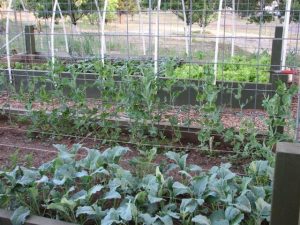Imagine a BLT sandwich with the tomato as the best part. Or your children following you out to the vegetable garden to snatch sugar snap peas or cherry tomatoes right off the vine. Flavors are much more intense from a home-grown garden.
Home vegetable gardening is easy to learn and cost effective. To begin, choose a spot in your yard that has at least six hours of sunlight and easy access to water. Building raised beds is as easy as nailing 2×4 boards into a rectangular shape. Raised beds make irrigation and soil improvements easier. If you have gophers or voles you will need to put gopher wire under the beds.
Soil preparation is one of the key components to success in vegetable gardening. Clear out the weeds and amend the soil with compost. Compost can be bought at any nursery, as well as at some local markets. Soil amendments are important for several reasons. First, they add nutrients to worn out soil. Most vegetables are annuals and have high production during the growing season. High production requires soil that is rich in nutrients. If you want abundant tomatoes or armfuls of flowers, you must feed those plants. Second, soil amendments enable the earth to retain moisture, giving the plants a more consistent level of water. Third, soil amendments loosen the soil, opening small pockets of oxygen – essential for root growth and energy uptake. After adding a new soil amendment, turn the soil with a shovel to mix it in and level it out.
The fun part is picking out what to grow. At this time of the growing season you will either have your seeds up and growing already or you will be buying established seedlings. By choosing tomatoes that have a VFN designation (resistant to verticillium wilt, fusarium wilt, and nematodes) you will save the heartache of sick, less productive, or dying plants.
If your family loves salsa, pick a fast grower like “Early Girl” tomatoes and then add jalapenos, cilantro, and red onions to complete your recipe. A trick for tomatoes, if you have limited space, is to plant two plants per hole. Plant tomatoes deep, leaving the top set of leaves exposed. Clip the lower leaves off before you bury the stem. The tomatoes will grow roots all along the entire stems, making the plants stronger and cooler. You will need sturdy tomato cages to support the plants.
As you plant, try to put plants together that have the same watering and fertilizing requirements. Tomatoes are heavy feeders and drinkers. Adding marigolds to your beds will help to discourage bugs below and above ground. Squash will be protected from squash bugs by planting nasturtiums nearby. Squash plants grow rapidly, so give the nasturtiums get a head start by planting them earlier than the squash. Aphids on the nasturtium plants are a sign that the soil is lacking in lime, so a quick dusting of lime will cure the problem.
Starter fertilizers build roots and protect the plants from disease. As the plants progress, use a vegetable fertilizer. This is low in nitrogen, controlling the plant growth so you will have more growth in the root system and in flower production, not just huge green plants without fruit. It is important to feed your vegetables regularly. Remember these plants are short lived and need food to build flowers that turn into vegetables.
Consistent water, fertilizer (again, organic compost is the best) and weeding will give you success with your vegetable garden. Try new kinds of vegetables and have tasty food for the rest of the year. There is nothing so delicious as a salad of lettuce, tomatoes, herbs and chives fresh from the garden. Happy gardening!
Julie Silva is a University of California Cooperative Extension Master Gardener of Tuolumne County.


